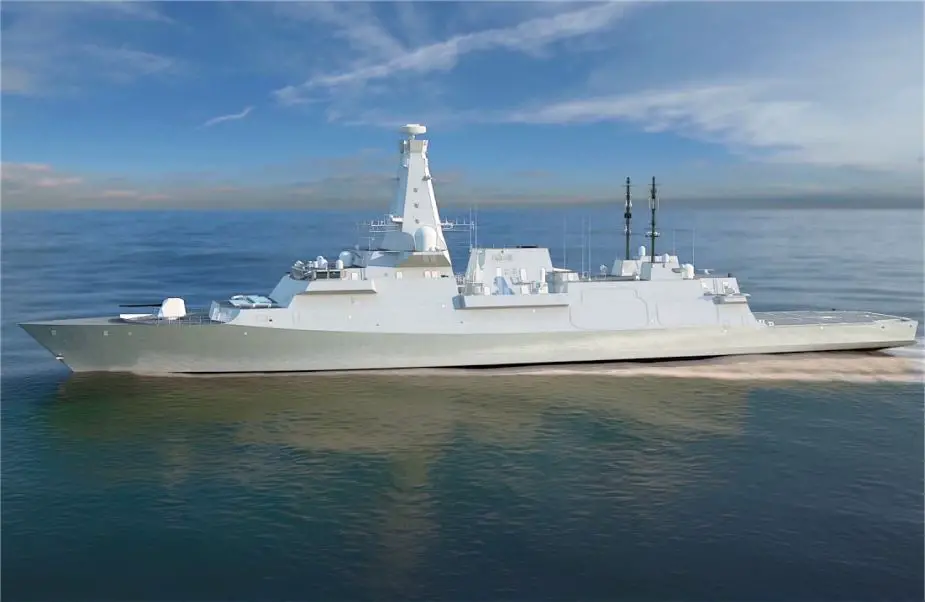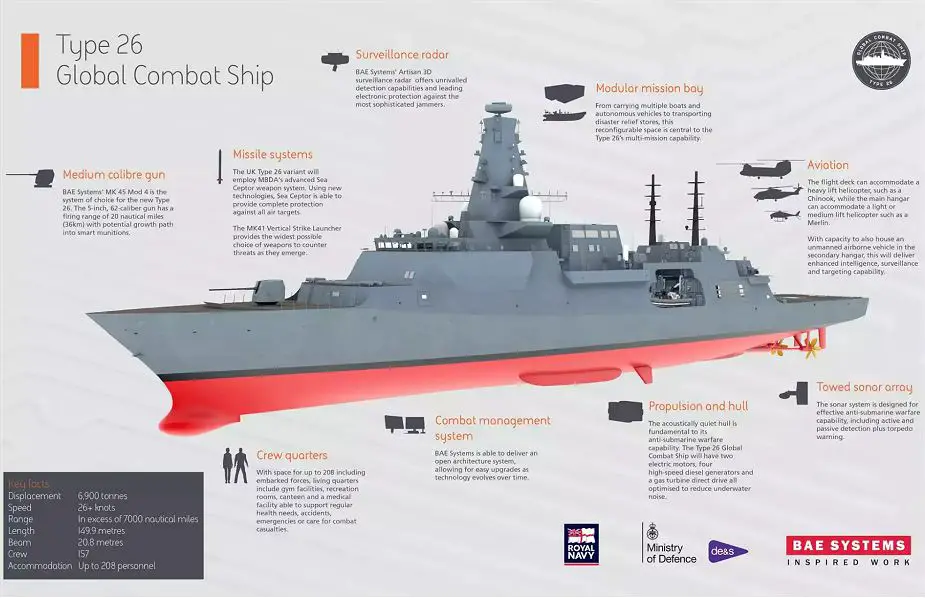The Type 26 or City Class frigate will be the next generation of multirole combat ship of the Royal British Navy, able to perform a full range of missions including maritime security, counter-piracy, counter-terrorism and humanitarian and disaster relief operations.
 Drawing of the next generation multirole frigate Type 26 (Picture source BAE Systems)
Drawing of the next generation multirole frigate Type 26 (Picture source BAE Systems)
The Global Combat Ship started development under the original Future Surface Combatant (FSC) program intended to replace the Royal Navy's Type 22 and Type 23 frigates, with the first set to enter service in the 2020s and the last remaining in service beyond the middle of the century.
The Global Combat Ship will be a highly capable and versatile multi-mission warship designed to support anti-submarine warfare, air defense and general-purpose operations anywhere on the world’s oceans.
With the design and development underpinned by a battle-proven pedigree of Royal Navy warships, the Global Combat Ship will be capable of undertaking a wide range of roles from high-intensity conflict to humanitarian assistance. It will be capable of operating independently or as a key asset within a task group.
On 2 July 2017, BAE Systems announced that the UK Ministry of Defence (MoD) had signed off on a £3.7b contract for the build of the first three Type 26 Global Combat Ships. The contract was a long time coming. What had initially begun in the late 1990s as the Future Surface Combatant program to replace the Royal Navy’s aging Type 23 vessels had been through various iterations before the design contract was placed with BAE Systems in 2010.
The first steel for the first three of eight Royal Navy ships was cut on 20 July 2017. BAE Systems announced the award of Type 26's first seven equipment manufacturing contracts in July 2015, these worth in excess of £170 million. Contracts were awarded to Babcock International for the ship’s air weapons handling system; David Brown Gear Systems Ltd for the propulsion gearbox and the test facility; GE Power Conversion for the electric propulsion motor and drive system and testing facility; Raytheon Anschütz for the integrated navigation and bridge system including customer-specific design and development, a land-based integration facility, and a wide range of services; Rolls Royce Power Engineering for the gas turbine; Rohde & Schwarz UK Ltd for the communications systems; WR Davis of Canada for the uptakes and downtakes of the ship's funnel and exhaust system.
The Type 26 will have a very powerful armament including BAE’s 5″/54 caliber Mark 45 main gun, two Phalanx CIWS (close-in weapons system), two 30mm DS30M Mark 2’s and the standard complement of miniguns and general-purpose machine guns. The Type 26 will have Sea Ceptor silo’s on the bow and at the funnel of the vessel. Additionally, it will carry MK 41 Vertical Launch System positioned behind the Sea Ceptor silo’s which are capable of firing missiles such as the Tomahawk land-attack cruise missile, anti-submarine rockets, a future anti-ship missile, or quad packed Sea Ceptor missiles.
According to the latest technical information published on Internet, the Type 26 will have a length of 149 m, reach a maximùum speed of 26 knots. It is expected to have 60 days endurance and have a range of 7,000 miles at 15 knots. It will have a crew of 118 sailors with room for a total of 208.




